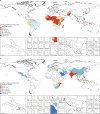Tracking spending on malaria by source in 106 countries, 2000-16: an economic modelling study
- PMID: 31036511
- PMCID: PMC6595179
- DOI: 10.1016/S1473-3099(19)30165-3
Tracking spending on malaria by source in 106 countries, 2000-16: an economic modelling study
Abstract
Background: Sustaining achievements in malaria control and making progress toward malaria elimination requires coordinated funding. We estimated domestic malaria spending by source in 106 countries that were malaria-endemic in 2000-16 or became malaria-free after 2000.
Methods: We collected 36 038 datapoints reporting government, out-of-pocket (OOP), and prepaid private malaria spending, as well as malaria treatment-seeking, costs of patient care, and drug prices. We estimated government spending on patient care for malaria, which was added to government spending by national malaria control programmes. For OOP malaria spending, we used data reported in National Health Accounts and estimated OOP spending on treatment. Spatiotemporal Gaussian process regression was used to ensure estimates were complete and comparable across time and to generate uncertainty.
Findings: In 2016, US$4·3 billion (95% uncertainty interval [UI] 4·2-4·4) was spent on malaria worldwide, an 8·5% (95% UI 8·1-8·9) per year increase over spending in 2000. Since 2000, OOP spending increased 3·8% (3·3-4·2) per year, amounting to $556 million (487-634) or 13·0% (11·6-14·5) of all malaria spending in 2016. Governments spent $1·2 billion (1·1-1·3) or 28·2% (27·1-29·3) of all malaria spending in 2016, increasing 4·0% annually since 2000. The source of malaria spending varied depending on whether countries were in the malaria control or elimination stage.
Interpretation: Tracking global malaria spending provides insight into how far the world is from reaching the malaria funding target of $6·6 billion annually by 2020. Because most countries with a high burden of malaria are low income or lower-middle income, mobilising additional government resources for malaria might be challenging.
Funding: The Bill & Melinda Gates Foundation.
Copyright © 2019 The Author(s). Published by Elsevier Ltd. This is an Open Access article under the CC BY 4.0 license. Published by Elsevier Ltd.. All rights reserved.
Figures





Comment in
-
Challenges in tracking global malaria spending.Lancet Infect Dis. 2019 Jul;19(7):672-673. doi: 10.1016/S1473-3099(19)30209-9. Epub 2019 Apr 25. Lancet Infect Dis. 2019. PMID: 31031173 No abstract available.
References
-
- Gething PW, Casey DC, Weiss DJ. Mapping Plasmodium falciparum mortality in Africa between 1990 and 2015. N Engl J Med. 2016;375:2435–2445. - PMC - PubMed
- PW Gething, DC Casey, DJ Weiss. Mapping Plasmodium falciparum mortality in Africa between 1990 and 2015. N Engl J Med, 375, 2016, 2435–2445 - PMC - PubMed
-
- GBD 2017 Disease and Injury Incidence and Prevalence Collaborators Global, regional, and national incidence, prevalence, and years lived with disability for 354 diseases and injuries for 195 countries and territories, 1990–2017: a systematic analysis for the Global Burden of Disease Study 2017. Lancet. 2018;392:1789–1858. - PMC - PubMed
- GBD 2017 Disease and Injury Incidence and Prevalence Collaborator, lobal, regional, and national incidence, prevalence, and years lived with disability for 354 diseases and injuries for 195 countries and territories, 1990–2017: a systematic analysis for the Global Burden of Disease Study 2017. Lancet, 392, 2018, 1789–1858 - PMC - PubMed
-
- GBD 2017 Causes of Death Collaborators Global, regional, and national age-sex-specific mortality for 282 causes of death in 195 countries and territories, 1980–2017: a systematic analysis for the Global Burden of Disease Study 2017. Lancet. 2018;392:1736–1788. - PMC - PubMed
- GBD 2017 Causes of Death Collaborator, lobal, regional, and national age-sex-specific mortality for 282 causes of death in 195 countries and territories, 1980–2017: a systematic analysis for the Global Burden of Disease Study 2017. Lancet, 392, 2018, 1736–1788 - PMC - PubMed
-
- Global Burden of Disease Health Financing Collaborator Network Past, present, and future of global health financing: a review of development assistance, government, out-of-pocket, and other private spending on health for 195 countries, 1995–2050. Lancet. 2019 doi: 10.1016/S0140-6736(19)30841-4. published online April 25. - DOI - PMC - PubMed
- Global Burden of Disease Health Financing Collaborator Networ, ast, present, and future of global health financing: a review of development assistance, government, out-of-pocket, and other private spending on health for 195 countries, 1995–2050. Lance, t 201, 9 published online April 25. http://dx.doi.org/10.1016/S0140-6736(19)30841-4 - PMC - PubMed
MeSH terms
LinkOut - more resources
Full Text Sources
Medical

